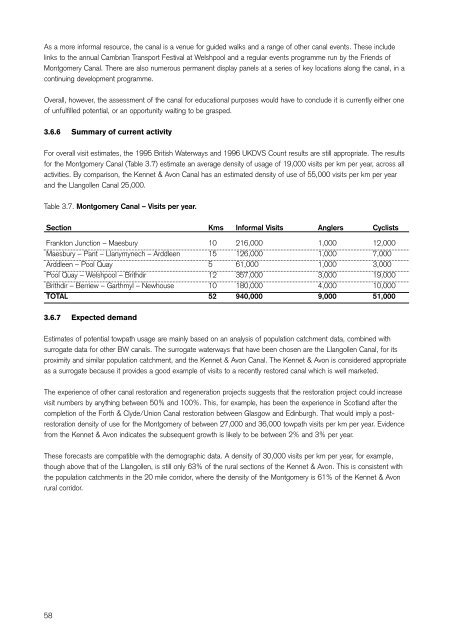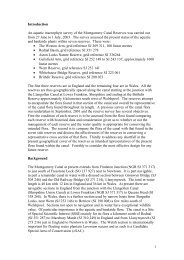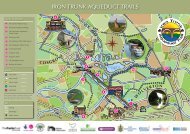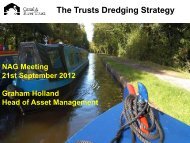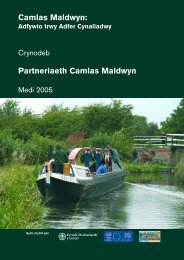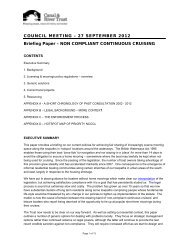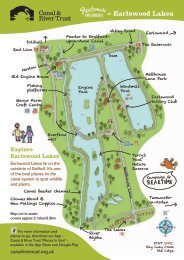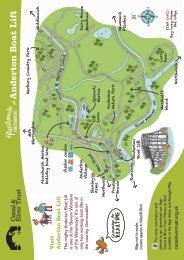Montgomery Canal Conservation Management Strategy (1.2MB PDF)
Montgomery Canal Conservation Management Strategy (1.2MB PDF)
Montgomery Canal Conservation Management Strategy (1.2MB PDF)
You also want an ePaper? Increase the reach of your titles
YUMPU automatically turns print PDFs into web optimized ePapers that Google loves.
As a more informal resource, the canal is a venue for guided walks and a range of other canal events. These include<br />
links to the annual Cambrian Transport Festival at Welshpool and a regular events programme run by the Friends of<br />
<strong>Montgomery</strong> <strong>Canal</strong>. There are also numerous permanent display panels at a series of key locations along the canal, in a<br />
continuing development programme.<br />
Overall, however, the assessment of the canal for educational purposes would have to conclude it is currently either one<br />
of unfulfilled potential, or an opportunity waiting to be grasped.<br />
3.6.6 Summary of current activity<br />
For overall visit estimates, the 1995 British Waterways and 1996 UKDVS Count results are still appropriate. The results<br />
for the <strong>Montgomery</strong> <strong>Canal</strong> (Table 3.7) estimate an average density of usage of 19,000 visits per km per year, across all<br />
activities. By comparison, the Kennet & Avon <strong>Canal</strong> has an estimated density of use of 55,000 visits per km per year<br />
and the Llangollen <strong>Canal</strong> 25,000.<br />
Table 3.7. <strong>Montgomery</strong> <strong>Canal</strong> – Visits per year.<br />
Section Kms Informal Visits Anglers Cyclists<br />
Frankton Junction – Maesbury 10 216,000 1,000 12,000<br />
Maesbury – Pant – Llanymynech – Arddleen 15 126,000 1,000 7,000<br />
Arddleen – Pool Quay 5 61,000 1,000 3,000<br />
Pool Quay – Welshpool – Brithdir 12 357,000 3,000 19,000<br />
Brithdir – Berriew – Garthmyl – Newhouse 10 180,000 4,000 10,000<br />
TOTAL 52 940,000 9,000 51,000<br />
3.6.7 Expected demand<br />
Estimates of potential towpath usage are mainly based on an analysis of population catchment data, combined with<br />
surrogate data for other BW canals. The surrogate waterways that have been chosen are the Llangollen <strong>Canal</strong>, for its<br />
proximity and similar population catchment, and the Kennet & Avon <strong>Canal</strong>. The Kennet & Avon is considered appropriate<br />
as a surrogate because it provides a good example of visits to a recently restored canal which is well marketed.<br />
The experience of other canal restoration and regeneration projects suggests that the restoration project could increase<br />
visit numbers by anything between 50% and 100%. This, for example, has been the experience in Scotland after the<br />
completion of the Forth & Clyde/Union <strong>Canal</strong> restoration between Glasgow and Edinburgh. That would imply a postrestoration<br />
density of use for the <strong>Montgomery</strong> of between 27,000 and 36,000 towpath visits per km per year. Evidence<br />
from the Kennet & Avon indicates the subsequent growth is likely to be between 2% and 3% per year.<br />
These forecasts are compatible with the demographic data. A density of 30,000 visits per km per year, for example,<br />
though above that of the Llangollen, is still only 63% of the rural sections of the Kennet & Avon. This is consistent with<br />
the population catchments in the 20 mile corridor, where the density of the <strong>Montgomery</strong> is 61% of the Kennet & Avon<br />
rural corridor.<br />
58


